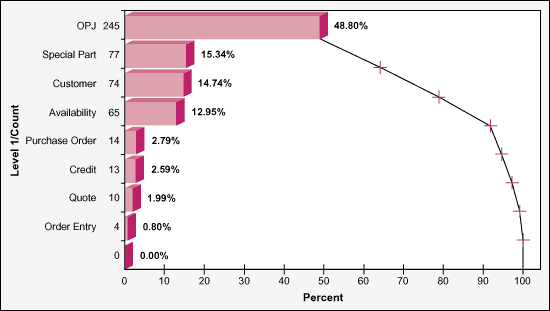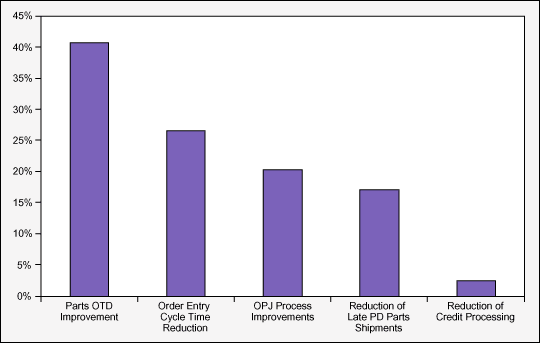
Liquid Controls, a manufacturer of high-quality flow meters and accessories for accurate liquid measurement, is a well-practiced user of Six Sigma methodologies. Having adopted Six Sigma in 1999 and made significant strides in improving manufacturing processes, the company more recently began to turn attention to transactional processes for serving customers. Liquid Controls identified several processes that were failing to meet customer expectations. Chief among these was the cycle time to fill a customer’s order. Customers wanted to have product delivered to them when they need it – not early or late.
The company, based in Illinois (USA), had evaluated the gap between customers’ expectations and its ability to meet those expectations, and found a meaningful area for improvement. By speaking with customers, company officials realized they had a shortfall in a critical-to-quality outcome (Y). But while this fact was easy to determine, like many organizations the company had no data that helped identify and understand the inputs (x) causing late deliveries. Additional investigation revealed there was no data collection system for several of the operations in order fulfillment. Much of the data needed resided in disparate data systems (the accounting package, the manufacturing control system, a logistics database and other software applications).
The barriers to acquiring this input data seemed almost insurmountable, even though the company had invested heavily in information technology that automated much of the processes. Manual collection was unrealistic. Given the volume of transactions and the nature of the data needed, the cost in manpower to collect input (x) data was prohibitive.
Working Towards a Solution in Action
The entire order fulfillment process was mapped and several factors that impacted cycle time were identified. But the lack of data was still the problem. It was at this point that management realized it must find a way to collect the input data of the order fulfillment process so the root causes of problems could be found and the Y controlled.
The decision was made to acquire a suite of data acquisition and defect management software and set up an automated process for extracting data from the company’s business system. The software calculates cycle times at critical milestones in the process, from the time an order is placed, to when supplied parts are ordered, to when production starts, to the time a product reaches the shipping dock. The automated system also captures supportive x information about the order such as complexity, product type, size, suppliers utilized and salesperson. This data has proved invaluable in driving improvements.
Today Liquid Controls automatically queries its order processing system every 15 minutes. Any time an order takes longer than 48 hours to process, the system calls it a failure and sends an email to the process owner (the sales engineer) and to the director of customer service. The email has a link in it that asks the process owner why this order is late. He is given a list of no more than eight reasons to choose from.

The system is set up for immediate response because the company knows from research that the sooner it asks for a response, the more accurate the data is. As the company has collected data on this process, it has been able to quickly drill down into the data to identify the biggest reasons for not meeting targets. This has become a key driver of the Six Sigma process because it helps identify areas that need improvement. For order entry, the company saw a reduction in cycle time from 4.5 days to 1.0 days in a four-month period. This is a reduction of nearly 80 percent.

The company has achieved these gains through a number of projects. One simple project focused on special orders. For example, it was discovered that one problem area that contributed significantly to late shipments was processing special orders. Special orders are orders that call for a product that uses a component part that is not in stock. A review of the process flow showed that when a special order was received, an order for the special component would be placed with a supplier and nothing would happen until the part was received. When the part arrived, production on the order would then begin. By studying the time suppliers needed to fill special component orders, the company was able to time release orders to production so that the special component arrived at the right time.This optimized shipments to Liquid Controls’ customers.
Collecting this type of data helped identify another project and prove that the cycle time could be reduced without compromising quality or causing problems in other areas of the business. In this situation, the system revealed that one of the significant delays in the order fulfillment process was a managerial approval of orders before they were placed in the production queue. The process owner (a salesperson) would submit the order for approval, and his or her manager was to review and approve the order before it entered production. The managers, being busy people, might not get to the approval for some time and the order would sit in the queue.
The Six Sigma team contemplated eliminating the approval step, but decided they needed proof that they could do so without causing problems downstream. After all, the team understood that it would not pay to eliminate one problem and create more problems later. They reasoned that the measure of the quality of the order was the number of change orders to any order. Prior to making any changes to their process, they confirmed that the number of change orders that hit the shop floor was a stable process. Then they trained the process owner to ensure they were able to do the job, and to communicate that they would no longer have their work checked by the manager. This empowered the process owner to do their job.
The results were dramatic. Order throughput went up dramatically because the managers were no longer a bottleneck. Process owners took more care (and pride) in their work because they had the responsibility. And through it all, there was no significant impact on the number of change orders that hit the shop floor.
Tangible Benefits
These projects have resulted in a significant (nearly 80 percent) reduction in the order delivery cycle time. This, in turn, reduces inventory carrying costs, as well as increased productivity of staff. In the company’s first year of operation, it also saw hard savings totaling more than 23 percent of the cost of poor quality in this one area, with some projects triggering a reduction of more than 40 percent.

Intangible Benefits
One of the most significant benefits from the efforts at Liquid Controls has been a shift from a culture where the Six Sigma community drives process improvements to one where the process owners – everyday employees – drive improvements. The company has shifted from a push system to a pull system. With the data acquisition and defect management software, the company’s systems people see how easily the data can be sliced and diced and it gets them thinking in new ways. Now, process owners are coming to the Black Belts and saying, “Could we apply that over here? I think it might help us get a handle on this problem, which has been bugging us for years.”